#french second empire architecture
Text

Lynchburg, VA c.1878
The William Carroll House was built by architect R.C. Burkholder. Wealthy Lynchburg tobacconist John W. Carroll had this house built for his son, William.
📸 Yours Truly
#photography#life#original photographers#black and white photography#mental health#virginia#on the road#my photos#historic architecture#mansard roof#french second empire architecture#second empire#empty spaces#abandoned#fixer upper#for sale#lynchburg#rural gothic#rural america#rural aesthetic#gothic architecture#one of my favorite houses#2019#still for sale#someone save this house
11 notes
·
View notes
Photo
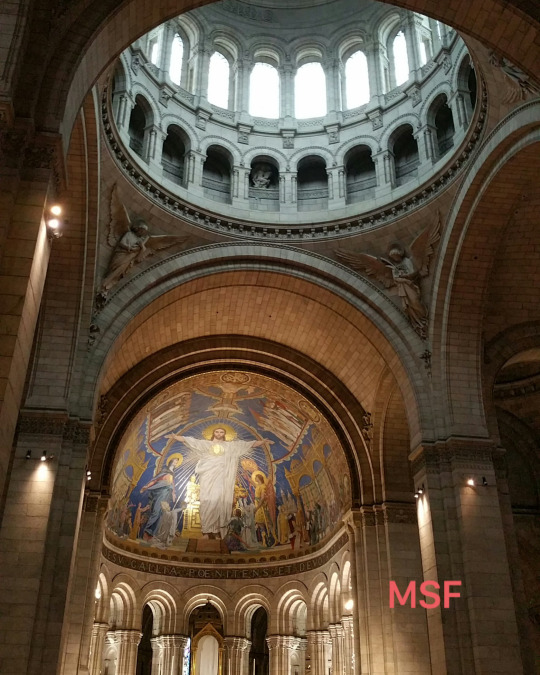
(vía Basílica del Sacre Coeur (1))
#arquitectura#architecture#Siglo XIX#19th century#Basílica del Sagrado Corazón#parís#Francia#France#Sacre Coeur#Paul Abadie#Guerra Franco-Prusiana#Franco-Prussian War#Second French Empire#Segundo Imperio Francés#Historia#History#Fotografía#Photography#Arte#Art
2 notes
·
View notes
Text
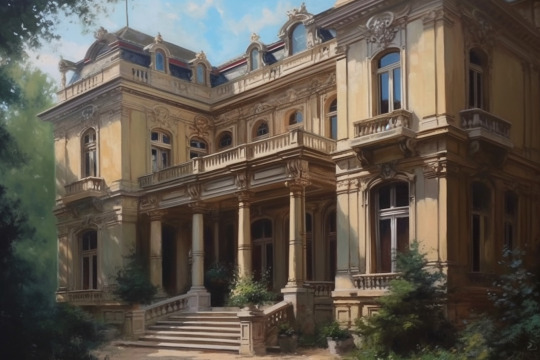
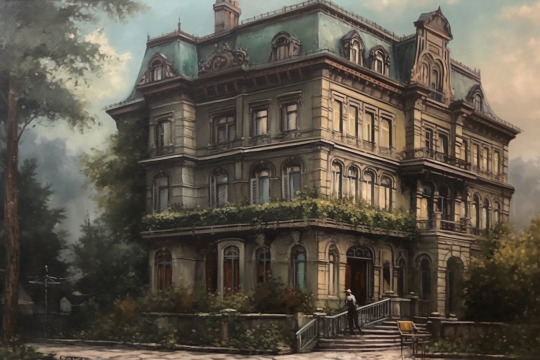

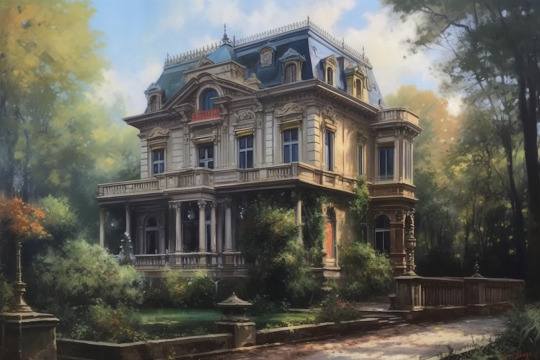
These are what the French call 'Hôtels Particuliers.' They are basically palatial townhouses for rich Parisians and in a former age, aristocrats.
by Midjourney v5
3 notes
·
View notes
Text
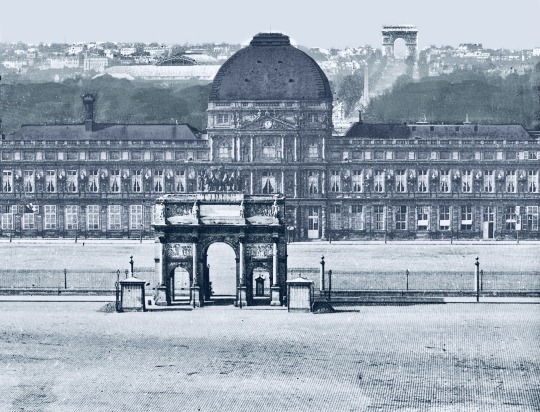
The Mythical Paris, circa 1860s
#Paris#France#2nd empire#1860s#19th century#architecture#Parisian#french#edit#second empire#French empire
5 notes
·
View notes
Text


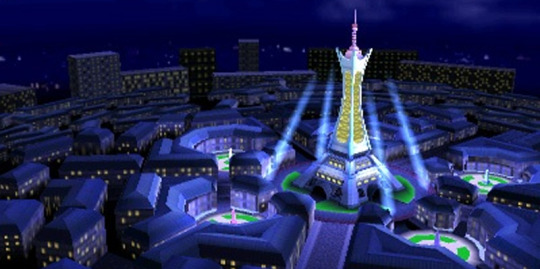
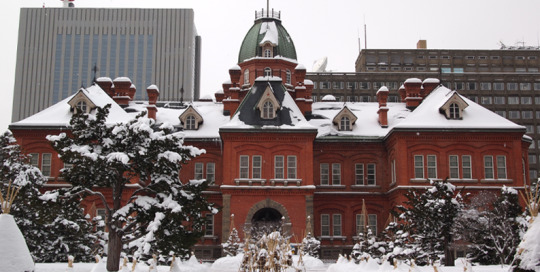

So, with the new legends there's a neat way we can take a guess at some of the time frame. Although it's largely aesthetic and hard to gauge the intended historical parallels of, the not-Eiffel Tower at the center of the city could presumably have been completed in the late 1880s like the real thing. Interestingly that places it pretty concurrent to the construction of the Hokkaido Government building in the 1870s that served as the basis of the Galaxy Team HQ in the first Legends game.
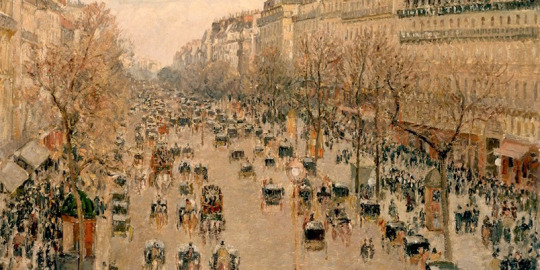
But with the keywords being "urban redevelopment" the setting could only possibly be Haussman's renovation of Paris that took place from the 1850s-1920s. So given that the tower is already standing, that places Legends Z-A between 1889 and 1927.
And I doubt it would play into the setting of a Pokemon game but I think it's neat that it would mean taking place firmly in the 3rd French Republic, as that's not typically the most romanticized period of French history. (Kind of shocking given just how much Japanese pop culture loves to fixate on the Ancien Regime and Rococco architecture.) It's right at the height of the French Colonial empire and their rivalry with the British... Even if they don't address the history directly, certainly not the darker bits, I wonder if we'll see an ancestor of Rose* and some mention of Kalos and Galar's relation as a hint at the Pokemon world's equivalent of India. (Elephant, what elephant...)
*put a pin in that... Well come back to Rose later...


Also I know a lot of the stupid "leaks" that were just running with any/every rumor they could find had been talking about Celebi, despite there being no signs of it in the direct, but it's possible that the Z-A title and the fadethru of the sort of sci-fi looking city diagram into a pencil and parchment one is indicating going back in time --backwards, from Z to A, end to start.
and just so long as I'm just picking at edges of things...


The unknown are an anagram of, "POKEMON PRESENTS"(oh and the SOEYUE one at the end is just "SEE YOU") and the ""confidential"" stamp on the documents likely reads "Gokuhi" as in gokuhi[極秘]: "Top Secret," but the rest of the text doesn't seem to match either Japanese, French, or English,




Hito to POKEMON no kyouzon o yumemite[人と ポケモンの共存を夢見て]: "Dreaming of people and Pokemon's coexistence"
Toshisaikaibatsu hassou MIARE CITY[都市再開発発想ミアレシティ]: "Urban Redevelopment Concept Miare City"
The obvious exception being that redacted text is clearly the romanized MIARE from the Japanese MIARE[ミアレ] and the English CITY, which is the Japanese name for what was localized as "Lumiose."
Curiously the word "Pokemon" is very clearly missing from the passage, and also in both cases there are too few "Galarian" characters for how long the phrases are in any actual language.

and finally, given some of the existing examples of handwritten Galarian in SwSh, I'm guessing the text on the big logo is as i've transcribed into the more standard Galar font, although I'm really uncertain about that second one, and a bit iffy about the big "X"s, but the little cyclone O, the V with the underbar, and the E seem certain enough.
Also there's a logo I know I remember seeing that looks like this one but I can't remember where it is or what it's associated with.... It's the logo on the Macro Cosmos power plant. Not Rose's personal logo with the stylized rose, and not the Cosmos business logo with the big star system orbital ring Cs, but the power plant in Hammerlock where you go to fight Eternatus specifically.
It would be really neat if whatever this organization is was tied back to an ancestor of Rose and Peony and the origins of Macro Cosmos somehow.

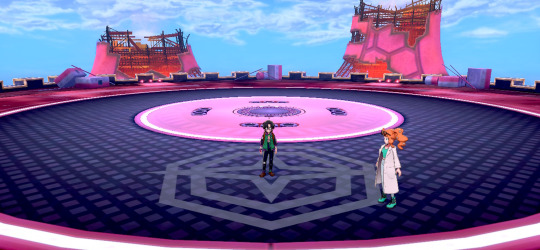
620 notes
·
View notes
Text
I think there should be a building game show for Minecraft. Like Lego Masters, most cooking shows, etc. Like listen. I think fighting is cool and all, and I myself was raised on watching bed wars and Minecraft hunger games and all that, but like also… builder are insane? Like I love watching, Empires, Hermitcraft, other big builders (and redstoners for that matter) because I’m so fascinated by how their brains work???? Like you’re telling me Bdubs took some dirt and made a literal mountain as a BACKDROP for his build in a season??????? Bro????? Like I want some builders to go head to head in a building challenge.
Like, okay hear me out, each week their “building themes” could go from mimicking IRL architecture styles - medieval, French colonial, minimalism, etc - OR could rely on game mechanics. Like you gotta make a build, but it must include five red stone functions - could be as simple of auto lighting and stuff - all the way to farms included into the make of the build!
Judging wise, I think that would be the hardest thing to pin down, because the issue with Minecraft building is that there are a lot of factors when it comes to the concept of building because every builder has an inherent “style” they have and so to compare isn’t necessarily fair???? Because what one person likes may not be the same as another person, so I don’t believe you can judge inherently on how a build looks, but more so if it fits the criteria - did you do your research and keep to the prompt 100% or did you take some liberties in the favor of making it seem stylistically “better” - also, while I am inclined to be like “hey look we could have it audience choice” I am aware that in previous Minecraft events - every tournament event live-streamed like ever - every YouTuber is gonna have bias on their side, and if there is someone with a larger viewership that others, there is of course going to be favor towards them. The ONLY way I could see this being different is if it was all pre-recorded and episodic, but I still believe there would be a heavy amount of bias if someone was on the show with more viewership than others. We would want it to be fair. I do think audience participation is important though, and should be a major inclusion! Like, before an event is to occur I think it would be fun to choose the prompt of what they’re building that week, but the contenders just can’t tweet/say/promote one they wish to do, so it is STRICTLY up to the audience without bias.
Also, I think everyone should come out a winner, not in the “No one came out on top because we are all equal” way - because while that is important it is still a tournament, and as we’ve seen in literally every competition show ever there is always a first place winner - but more so in the, while you didn’t win, let’s reflect on how you are still fantastic and getting something out of this. I know it sounds a little basic, so I do think it would need to be extrapolated on. But I wouldn’t want anyone who “loses” to just go away with “you got clout” award. You were featured on the show, that’s inherent, you deserve more than that, again this can be fleshed out later, but they deserve more too, somehow.
Also for the finalists - I’m thinking either 3 left or 2 left - it should be a mega build level prompt. Could be something like “build a city!” Or just “build a mega base with x block being the main block” and, again, not sure how it would be judged, but winner comes out, with second/third place having some reward as well, not as good, but still considerably great. I also think it would be fun to have prior contestants come on and have to participate in the “here is your block that I got to choose for you” to add some spice to it. IDK what the prize would be, I know it is normally money, and while it could be that, I think it would be more fun to have something a little different that would still be fun and a true “winners” item. Again, not sure what it could be, but it would need to hold to the truth of “oh, hey, this is a true prize and its still fun and I’m getting something out of this!”
Anyhow, enjoy the strange thoughts of my brain and if any streamers/youtubers are out there reading this, lemme know what you think cuz I’m curious. Do I think I could ever do this? Probably not cuz I’m an opera singer doing my masters so time is bet a dream to me at this point, but like. I think it is interesting and would love opinions on it just from the standpoint of discussion. I streamed at one point, maybe I’ll start back up again one day if only to have fun. I feel like that should be what it is, fun, that is the most important thing at the end of the day and builders should have some competitive fun too!
Also, I will admit that I am obviously not knowledgeable on everything - again opera singers not full time Minecraft anything - so I don’t know if something like this has been done before, and while I think it would be cool if something like this existed, it may already exist and I quite simply don’t know! Thoughts, opinions, anything else?
Anyway, if anything, have a good day!
96 notes
·
View notes
Note
so you got me interested in reading the history of shit but feel slightly intimidated as i have very little experience in european history and basically none in french history at all, and none for history of health/disease/etc. i was wondering if you have any recommendations for readings to get at least a basis in this so i can appreciate and understand the read more? what do i need to know going into it?
[yes sickos voice] so i actually think 'history of shit' is relatively friendly to those without a huge base of historical knowledge, if only because it's less grounded in actual historical analysis than in theoretical and conceptual work. you should be aware of the french 'mission civilisatrice' as a guiding principle of imperial and colonial expansion, and its importance in hygienic rhetoric and reform projects in the french colonies (eg, the hanoi rat massacre or attempts at scientised architectural reform in algeria or morocco). you should also know that paris in particular has a recent history of taking a special kind of pride in its sewer system (which, to be clear, did exist prior to the second empire [1851-1870] but was certainly greatly expanded during this period) and using the fact of having a sewer system as evidence of its great 'modernity', 'cleanliness', &c. but, i don't think you need to delve deep into historical texts prior to reading 'history of shit'; if anything, it might be more enjoyable to read laporte first (it's a funny book on purpose!) and then do any further historical research that piques your interest. 'history of shit' is working largely within a lacanian and freudian framework, though certainly also with an awareness of principles of marxist analysis; again, though, i don't think you need to be an expert in psychoanalysis to read this book. maybe skim a summary of freud's 'civilisation and its discontents' if you're feeling very shaky on this aspect.
if you do want to read further into french history on this topic, some first places to go would be donald reid's 'paris sewers and sewermen' (kind of the go-to historical monograph on the parisian sewer system) or alain corbin's 'the foul and the fragrant'. david barnes has also written some great papers on parisian sanitary engineering, including the 'great stinks', and public health. 'history of shit' also bears certain foucauldian fingerprints and has a lot of literary and cultural analysis; you might have fun following some of those references. i read it without having read most of the literary works cited and still found it very engaging.
36 notes
·
View notes
Text
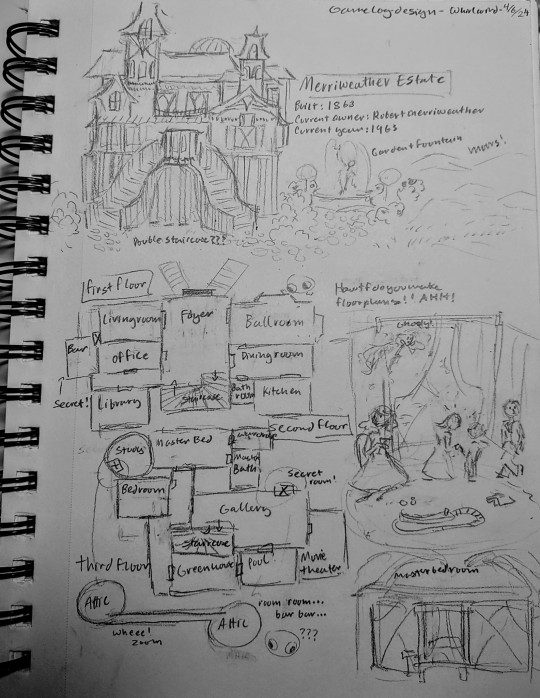
Hey guys!!! Sorry for the wait on this post, just catching up on some schoolwork:')
So!! Here is the main location of Whirlwind. It's this big manor called the Merriweather Estate! My main inspiration is french second empire architecture with Gothic elements, and I'm pretty happy with how it looks, at least from the outside, right now. I might change around the inside layout but for now I think it works fine. I also really wanted to include a big garden section outside that has flowers and fountains and statues. I'm placing the manor next to some moors for the Wuthering Heights vibe.
Right now im wondering what I should do for the point of view. Idk if I want to go with an isometric pov or third person. Next post will hopefully be another character!! Thx for reading:)))
7 notes
·
View notes
Text
Love in the French Middle Ages (1)
Here is a compilation of what I think is the most interesting or informative part of my French literatureXsocial science university class, centered around “Love, in all of its forms, in the French Middle Ages”.
# At the beginning of the class we had of course a reminder about what period of the world’s history is the Middle Ages, but I will place it back here because too many people still believe the Middle Ages are clear cut. The most common date associated with the beginning of the Middle Ages is 446, the fall of the Western Roman Empire, which marks the end of Antiquity. Most people choose this date because it marks at the same time the fall of a political regime AND the end of an entire culture. But in the same logic, others point out that the Middle-Ages began in France with the baptism of Clovis, which marked the end of the Roman domination in France and started a new, Christian era. Of course, the problem with pin-pointing exact dates for “historical eras”, is that it is impossible, since historical changes always take a long time. But the common ground is that with the fall of the Western Roman Empire, and the destruction of the Roman culture, the Middle-Ages began. For when the Middle-Ages ended, we also have several different dates. For some, it is when the Americas were “discovered”, in 1492. For others it is when Gutenberg invented the printing press in 1440, which modified forever humanity’s relationship to culture, literature and writing. For a third group yet, it is the fall of Constantinople, in 1453, and the end of the Eastern Roman Empire/Byzantine Empire. This date is notably chosen because with the fall of this Empire, all the Byzantine and Greek scholars fled to the West, which would cause the “rediscovery” of today’s “classics” of Antiquity, ushering forth the Renaissance. So the Middle-Ages is a VAST era. Roughly a thousand years old. For this class we didn’t focus on the Early Middle Ages (le Haut Moyen Âge in French), that went from 446 to the year 1000, the era of the Merovingians, Carolingians and Charlemagne. No we rather focused on the second half of the Middle Ages, “le Bas Moyen Âge”, the Late Middle Ages.
A quick reminder of why the Middle Ages are called “Middle”. It is because the Middle Ages, as a historical era, was ceonceived when it was other, it was retrospectively defined as an intermediary, in-between era going from Antiquity to the Renaissance. People only realized the “Middle Ages” existed when Renaissance began. With the Renaissance, there was a supposed “return of literature” and an “end to the Gothic darkness”, the humanists claimed the times preceeding them were barbarism and savagery - gothic savagery! It were the humanists that created the “dark legend” of the Middle-Ages. [Note: Interestingly, while today “Gothic” is an adjective designating a specific type of architecture, in the 16th century, during the Renaissance, “Gothic” didn’t meant this at all - it rather was an adjective related to the Goths, the Germanic tribes that invaded the Roman Empire at the end of Antiquity. So when humanists qualified the Middle-Ages of “gothic”, they meant “of the same savagery as those barbaric Goths that destroyed the glorious Roman Empire”, it was supposed to be a heavy caricature.] Hopefully, against this strong denigration, there was an idealization of the Middle Ages during the 19th century, notably by the Romantic and Royalist movements... but this resulted in a new backlash making in people’s mind the Middle Ages even more “barbaric” and “repulsive”. Even today, in the French language, there is a confusion between “médiéval” (the “medieval” adjective that means “belonging to the Middle Ages”) and “moyen âgeux”, “Middle Ages-like”, which is a derogatory term to designate something outdated, uncivilized or backwards. So today, there is a true effort by modern researchers and experts, by dedicated medievalists, to restore the actual Middle Ages into the mind of the people.
# Another fun fact: while today the “Renaissance” designates this historical era that starts roughly around the 16th century, there are actually other “Renaissances”... In the Middle-Ages! See, there is already a first Renaissance, called the “Carolingian Renaissance”, around the 800s. Charlemagne was ruling over a very vast empire, and under his rule there was a true boom of schools (not schools per se, but schools located in monasteries) - numerous schools were created, teachers and pupils were recruited left and right, lot of people learned how to read Latin and read the literature of the Antiquity (especially Cicero). This is why today in France you often hear “Charlemagne created school”. This educational movement was also tied to another intellectual movement focused on building up theology - and these two movements made the “Carolingian Renaissance”.
But there was another one, even more important! The Renaissance of the 12th century. People abandoned wooden castles for stone castles, for a better security. There was both a growth in population and in riches - and, of course, an intellectual growth too. It was the era of Chrétien de Troyes, and of Héloïse et Abélard, a couple part of the French literature history, well-known due to the letters they exchanged. Abélard was an intellectual, a scholar of the 12th century, who notably had numerous debates with another great name of the century, the monk Bernard de Clairvaux - and one of those debates was about the nature of love. Abélard was a truly typical Parisian clerc, and through his letters to Héloïse we discovered the history of their shared and passionate love (for example in one of Abélard’ letters, titled “Histoire de ma vie”, Story of my life, he explained to Héloïse where his passion for her was born, a passion so strong it caused troubles for him, since he is a clerc...).
[Note: The term “clerc” I use here is the French term for... *quick Google Search* cleric. In the medieval society, there was a three-part divide: the clercs, the nobles, and the others. The others were those that worked ; the noblesse were not those that worked, but those that made war - they were the warriors and the military group of the society. And the clercs were the clerics - clerc was a general denomination for all men of the Chuch, they were “those that pray”. The clergy notably had the monopoly of the institutional culture. In the 12th century there was a development of the university, and a boom in students - but this development was done under the rule of the clerics, these early university were “cathedral-schools” (opposed to the monastery-schools I talked about before), and all these students... were actually clercs! Because, remember, the society is divided between “those that work” and “those that don’t work”. The students don’t work (as in physical, manual labor), and since they don’t go off to war and aren’t noble, they are by default joined with the clerics. This is notably this intertwining of the clerics with studies that made it very difficult for women at the time to access knowledge.
Another point that explains why the 12th century was a “Renaissance”: it is noted that during this century, there was a renewed interest in the literature of the Antiquity. So the whole idea that “Antiquity was rediscovered by the 16th-century Renaissance” is false - people already knew and were interested by the literature of Antiquity during the Middle-Ages. What was rediscovered by the “proper” Renaissance was GREEK Antiquity, but already by the 12th century France had rediscovered the Latin Antiquity and its texts. Most notably, the poems and texts of Ovid, which all were heavily centered around love (his text “The Art of Love” was a best-seller in the 12th century). Most notably, Bernard de Chartres described this rediscovery of the literature of Antiquity is a very beautiful sentence: “Nous sommes comme des nains juchés sur les épaules de géants”. “We are but dwarfs on the shoulders of giants”.
# What truly defined the Renaissance in France was many other things than this misplaced “rediscovery of Latin”. It was the era of the “Great Discoveries” and world-travels ; it was an era where the French language was praised, worked on and spread (against the “dead languages” that were the Greek and Latin) ; and it was also the time of the religious wars. This last point is very interesting: the Renaissance was a time where Christianity split itself in two and knew a nasty civil war, between Catholics and Protestants. But the medieval society was fully and completely united in its Christianity - in France, beyond Christianity, there were only the Jews, but they were a minority either oppressed, either forced into exile. Another reversal of ideas: there are a lot of things we think of as “Middle-Ages-like” that were actually still existing by the Renaissance. Saint-Eustache, one of the Gothic churches of France, was built in 1536. Henry II died in a medieval-like tournament, despite being a 16th century man.
No, what truly defined the Renaissance was the humanism. In the Middle Ages we had the Petrarquism, following Petrarca, this time of sonnet-based poetry that marked Europe so much that the Pléiade herself (a famous group of poets of the French Renaissance) wanted to return to the Petrarquism. Petrarca’s greatest ork was “Canzioniere”, a work in “vulgar language”. One should remember that until quite recently, any language that wasn’t Latin or Greek was “vulgar language”, and Canzioniere was written in the Toscan dialect. And the Canzioniere was a series of poems all consecrated to Laura, a girl he knew in the town of Avignon, and who died - the Canzioniere is an attempt at maintaining this love even after the loved one’s death, and they gather what was called “erotic poems” (actually romance poetry) and “mystical poems” (religious poetry). Petrarca hoever had a role to play in the rise of humanism: Petrarca wanted to write in Latin to imitate Cicero, he had a great love for the literature of Antiquity and its authors. Petrarca was a leader in the desire to find back the lost or forgotten texts of Antiquity, and he was one of the first to put together the “method” of understanding these texts for what they were, for what they actually meant to say, with the consciousness that many things are separating the “present day” reader from the text of the past - he was one of the “founders” of the “historical consciousness” as we would put it today. This was a VERY important thing because in the Middle Ages the “consciousness of the Antiquity” was lost, or modified beyond anything recognizable. The medieval scholars never thought about the historical or social differences that separated them from the texts of Antiquity - and they judged these texts with the same criteria, concepts and principles they used to judge and criticize their contemporaries. Humanism brought forward the idea that Antiquity was over, was a “time of the past”, not just a continuation of “today”.
# Random fact: At the time of Petrarca, university only taught three different subjects. Theology, the law, and medecine. That was it, there was nothing else at the university.
# But let’s put aside all this context about the Middle Ages. Let’s start talking about the thing we are here for... love. Precisely “L’amour courtois” - Courtly love. And by extension, La littérature courtoise, Courtly literature.
There is a common saying that claims “Love was invented in France in the 12th century”. This is false because there was a love literature long before the 12th century. Courtly love was quite similar to a “fashion” or a “fad”. There were rules, though they had never been written anywhere, nor clearly spelled out by anyone - and these rules were idealized through the medium of literature. And this courtly love was actually about the coexistence of two different loves. There was the “common” love shared by everyone and that was thought to be natural at the time: the love for God. But this love, in the courtly literature, had to co-exist with a new love: the love for the lady (never for the wife!), a type of love specifically created for the nobility. This is what we call courtly love, “amour courtois” in French, though “amour courtois” is a 19th century term created by Gaston Paris. To avoid anachronism, the correct term, proper for the Middle Ages, would be “fin’amor”. The adjective “courtly” was used for people (those that felt or worked for the courtly love), but also for concepts. For example, the concept of moderation - a person feeling a courtly love must contain themselves. It is also tied to the “joven”, the youth - but interestingly this “joven” isn’t tied so much to actual physical age, than to “the ability to give yourself to someone else, and to sacrifice yourself for someone else”. This courtly love could work in one of two ways (often complementary): either it was thought that this type of love was only aimed at or “deserved by” courtly people ; either it was thought that by feeling this type of love, people “became” courtly themselves.
The term “courtois” in French doesn’t mean just “courtly” but also “courteous” or “mannerly”, and the associated name, “courtoisie”, would be translated in English by “courtesy”, though this medieval “courtesy” or “courtliness” was based on social codes VERY different from our modern social codes. Of course, you noted it, “courtesy”, “courtliness” comes from “court”, “la cour” in French: this social phenomenon was born, before all, inside courts. The courtly literature was tied to the princely courts, it was tied to the nobility and expressed the ideals of the nobility. But ideals which were also tied to the clergy - because upon seeing the huge popularity of this literature among the nobles, the clerics of course jumped in. And why were they worried about it? Because this courtly love, and this courtly literature, was invented at the court, shared by nobles and clerics... but it was a pure invention of the nobility, that is to say the secular part of the court, the “laïc” part as we call it in French, with no involvment whatsoever of the clergy. [Of course, the masses, the workers, were not at all concerned by the courtly literature, and had no dealing with it. The only type of literature that belonged to the masses was “les fabliaux”].
Courtly love is actually born in southern France, and then moved up to the north. One of the early heralds of courtly love was Guillaume d’Aquitaine, one of the first “poet-lords”. He welcomed in his courts numerous troubadours, including the now famous Jaufré Rudel. A troubadour was a professional singer and poet, always of the noble class (female troubadours, like Marie de Ventadour, were called trobairitz). This fashion of courtly love then spread to the north (if you do not know, during this era France was divided in North and South, not just by the politics and culture, but also by the very language - Southern France spoke the “langue d’oc”, the language of oc, while the North spoke the “langue d’oïl”, and modern French is a descendant of the northern dialect, which “won” against the southern one). An example of how this southern fashion went to the north: the duchess of Aquitaine, Aliénor d’Aquitaine, married her daughters to several lords of the north. Most notably, one of her daughters sent north was Marie de Champagne, who brought all sorts of clerics and scholars to her court, and it is for her that Chrétien de Troyes dedicated his novels. A second “travel” of the courtly love, and the last, was a travel from France to Sicily - which at the time was under the rule of the Anjou dynasty. So in the 13th century Sicily, a form of poetry very similar to the continental courtly love was adopted - and this Sicilian poetry (remember, Sicily was where Petrarca’s poetry was born) influenced and inspired numerous authors located north of Italy, especially Tuscany authors, including a certain... Dante. [What is also very interesting is that in Italy at the time there wasn’t the same system of princely courts as in France, and as a result, by reaching Italy, the courtly love actually managed to “break free” from the courts]
# Why is love so important in this era? Why did love became the subject of all philosophers, and the center of various ideologies? Because at the time, Christianity had decided to put love at the heart of its thoughts and discussions. In this era, the religious commandements were “re-organized” and given a new hierarchy, with the one coming at the top being “You shall love God and your neighbor”. This resulted, for the Middle Ages, into love becoming an ideal. Love was present in all four of the Gospels, “God is love”, “Love stays beyond death”, etc... But with this very strong idealization, there was a lack. All the speeches, all the discourses about love, were about the clerics. The monk was seen as the model-life, as the living example of love. Due to this religion-focused thinking, the secular world lacked any true “example” of love - this whole love discourse didn’t “plan” for the secular people to participate in this “divine love”.
#french middles ages#notes from university#middle ages#medieval love#courtly love#french literature#medieval literature#french history
23 notes
·
View notes
Text
𝟮𝟭 𝗳𝗮𝗰𝘁𝘀 𝘆𝗼𝘂 𝗱𝗶𝗱𝗻'𝘁 𝗸𝗻𝗼𝘄 𝗮𝗯𝗼𝘂𝘁 𝗥𝗼𝗺𝗮𝗻𝗶𝗮:
1. Approximately one-third of the Carpathian Mountains are located in Romania, offering stunning landscapes and serving as a habitat for the largest population of brown bears in Europe.
2. Bram Stoker's famous vampire, Dracula, was inspired by the historical figure Vlad the Impaler, who was a prince of Wallachia, a region in Romania. Bran Castle is popularly known as "Dracula's Castle" and is a major tourist attraction.
3. Romania is the 12th largest country in Europe and the 7th most populous member state of the European Union.
4. Romanian is a Romance language, sharing roots with Italian, Spanish, French, and Portuguese, reflecting the Roman heritage of the region.
5. The capital city, Bucharest, is known for its large administrative building, the Palace of the Parliament, which is the second-largest administrative building in the world after the Pentagon.
6. The Danube Delta, Europe’s second-largest and best-preserved delta, is a UNESCO World Heritage site and a biosphere reserve, known for its rich biodiversity, including over 300 species of birds.
7. The painted monasteries of Bukovina, in northeastern Romania, are famous for their exterior frescoes. These UNESCO World Heritage sites depict biblical scenes and are a testament to Byzantine art.
8. Known as one of the most spectacular roads in the world, the Transfăgărășan highway was constructed as a strategic military route and offers breathtaking views and a thrilling driving experience.
9. Romania was the first country in the world to officially record its oil production in international statistics in 1857. It also opened the first oil refinery in 1856.
10. On the shores of the Black Sea, Constanta is one of the oldest continuously inhabited cities in Romania and features ancient ruins and modern resorts.
11. The inventor of the modern jet engine, Henri Coanda, was Romanian. He built and flew the first jet-powered aircraft in 1910.
12. Romania is home to one-third of Europe’s mineral and thermal springs, and its spa towns have been known for their therapeutic treatments since Roman times.
13. Unique folkloric traditions, such as the 'Bear dance' and 'Capra (goat)', are performed during Christmas and New Year's celebrations, which are meant to purify and fertilize the soil for the upcoming year.
14. Formerly the center of the Transylvanian Saxons, Sibiu was named a European Capital of Culture in 2007 and is renowned for its Germanic architecture.
15. Romania has a rich religious heritage including Eastern Orthodox, Roman Catholic, and Greek Catholic churches, reflecting the diverse cultures that have influenced the country.
16. Located in Sinaia, Peles Castle is considered one of the most beautiful castles in Europe and was the summer residence of Romanian kings.
17. The name 'Romania' comes from the Latin 'Romanus' which means 'citizen of the Roman Empire.' The region was conquered by the Romans in 106 AD.
18. The Merry Cemetery in Săpânța is famous for its colorful tombstones with naïve paintings describing the people who are buried there as well as scenes from their lives.
19. The traditional Romanian blouse, or 'ie', has inspired many fashion designers and is celebrated annually on the "Universal Day of the Romanian Blouse."
20. Romania has 13 national parks and three biosphere reserves, showcasing the country's commitment to conservation.
21. The Romanian film industry has gained international acclaim over the years, with movies like "4 Months, 3 Weeks and 2 Days" winning the Palme d'Or at the Cannes Film Festival.

#romania#romanian#românia#țara mea frumoasă#țara mea de dor#românia mea frumoasă#history#history of romania#istorie
4 notes
·
View notes
Text
Mystic Manor at Hong Kong Disneyland: The Ultimate Guide
why does mystic manor have no ghosts?
- in chinese culture, people typically see ghosts as their ancestors so it would be considered quite disrespectful and weird if disney decided to place a haunted mansion with ghosts there
what year is mystic manor canonically set in?
- the actual manor was built in 1896 but the museum was not completed until 1909 or 1910. this is the same time when lord henry acquired the balinese music box
if there are no ghosts in mystic manor, what drives the storyline?
- part of mystic manor’s story heavily relies on both historical and mythological allusions including references to key historical and mythological figures throughout the attraction including hercules (in the form of a greek amphora), medusa (in the form of a mosaic) , striborg, the slavic god of winter (in the form of a painting), the tragedy of ragnarok (in the form of a vanity mirror), ra and ihy, the egyptian gods of the sun and music (in the form of clay tablets), and the monkey king from chinese mythology (in the form of a carved statue)
- references to 18th, 19th and 20th century royalty can also be found through both objects and names. both lord henry and albert’s names are references to two sons of king george v; prince henry, duke of gloucester and prince albert, duke of york (later king george vi) to which their father ascended the throne at the same time lord henry found the balinese music box (circa 1910)
- additionally, there are also references to the french and russian royal families in the form of a vanity fan depicting king louis xvi and marie antoinette within the queue’s display case and a violin belonging to tsar alexander i inside the russian room of the explorers club restaurant
what architectural style is the manor?
- creatively dubbed, “tropical victorian eclectic”, the manor’s architectural style is based on traditional victorian queen anne architecture, as well as gothic revival and second empire but also includes other architectural elements from different countries such as traditional chinese and muscovite russian
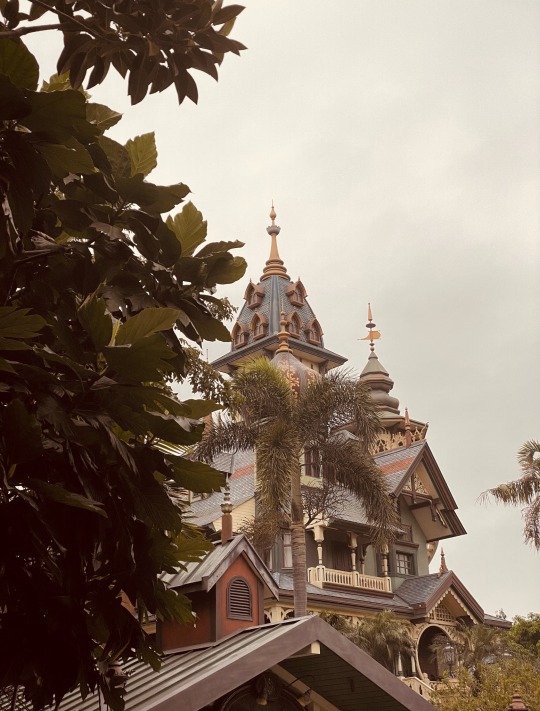
#haunted mansion#mystic manor#society of explorers and adventures#hong kong disneyland#disney parks#s.e.a
2 notes
·
View notes
Text
November 13th: Yokohama
At dawn on the 13th the “Carnatic” entered the port of Yokohama. This is an important port of call in the Pacific, where all the mail-steamers, and those carrying travellers between North America, China, Japan, and the Oriental islands put in. It is situated in the bay of Yeddo, and at but a short distance from that second capital of the Japanese Empire, and the residence of the Tycoon, the civil Emperor, before the Mikado, the spiritual Emperor, absorbed his office in his own. The “Carnatic” anchored at the quay near the custom-house, in the midst of a crowd of ships bearing the flags of all nations.
Passepartout went timidly ashore on this so curious territory of the Sons of the Sun. He had nothing better to do than, taking chance for his guide, to wander aimlessly through the streets of Yokohama. He found himself at first in a thoroughly European quarter, the houses having low fronts, and being adorned with verandas, beneath which he caught glimpses of neat peristyles. This quarter occupied, with its streets, squares, docks, and warehouses, all the space between the “promontory of the Treaty” and the river. Here, as at Hong Kong and Calcutta, were mixed crowds of all races, Americans and English, Chinamen and Dutchmen, mostly merchants ready to buy or sell anything. The Frenchman felt himself as much alone among them as if he had dropped down in the midst of Hottentots.
He had, at least, one resource,—to call on the French and English consuls at Yokohama for assistance. But he shrank from telling the story of his adventures, intimately connected as it was with that of his master; and, before doing so, he determined to exhaust all other means of aid. As chance did not favour him in the European quarter, he penetrated that inhabited by the native Japanese, determined, if necessary, to push on to Yeddo.
The Japanese quarter of Yokohama is called Benten, after the goddess of the sea, who is worshipped on the islands round about. There Passepartout beheld beautiful fir and cedar groves, sacred gates of a singular architecture, bridges half hid in the midst of bamboos and reeds, temples shaded by immense cedar-trees, holy retreats where were sheltered Buddhist priests and sectaries of Confucius, and interminable streets, where a perfect harvest of rose-tinted and red-cheeked children, who looked as if they had been cut out of Japanese screens, and who were playing in the midst of short-legged poodles and yellowish cats, might have been gathered.
The streets were crowded with people. Priests were passing in processions, beating their dreary tambourines; police and custom-house officers with pointed hats encrusted with lac and carrying two sabres hung to their waists; soldiers, clad in blue cotton with white stripes, and bearing guns; the Mikado’s guards, enveloped in silken doubles, hauberks and coats of mail; and numbers of military folk of all ranks—for the military profession is as much respected in Japan as it is despised in China—went hither and thither in groups and pairs. Passepartout saw, too, begging friars, long-robed pilgrims, and simple civilians, with their warped and jet-black hair, big heads, long busts, slender legs, short stature, and complexions varying from copper-colour to a dead white, but never yellow, like the Chinese, from whom the Japanese widely differ. He did not fail to observe the curious equipages—carriages and palanquins, barrows supplied with sails, and litters made of bamboo; nor the women—whom he thought not especially handsome—who took little steps with their little feet, whereon they wore canvas shoes, straw sandals, and clogs of worked wood, and who displayed tight-looking eyes, flat chests, teeth fashionably blackened, and gowns crossed with silken scarfs, tied in an enormous knot behind an ornament which the modern Parisian ladies seem to have borrowed from the dames of Japan.
Passepartout wandered for several hours in the midst of this motley crowd, looking in at the windows of the rich and curious shops, the jewellery establishments glittering with quaint Japanese ornaments, the restaurants decked with streamers and banners, the tea-houses, where the odorous beverage was being drunk with “saki,” a liquor concocted from the fermentation of rice, and the comfortable smoking-houses, where they were puffing, not opium, which is almost unknown in Japan, but a very fine, stringy tobacco. He went on till he found himself in the fields, in the midst of vast rice plantations. There he saw dazzling camellias expanding themselves, with flowers which were giving forth their last colours and perfumes, not on bushes, but on trees, and within bamboo enclosures, cherry, plum, and apple trees, which the Japanese cultivate rather for their blossoms than their fruit, and which queerly-fashioned, grinning scarecrows protected from the sparrows, pigeons, ravens, and other voracious birds. On the branches of the cedars were perched large eagles; amid the foliage of the weeping willows were herons, solemnly standing on one leg; and on every hand were crows, ducks, hawks, wild birds, and a multitude of cranes, which the Japanese consider sacred, and which to their minds symbolise long life and prosperity.
As he was strolling along, Passepartout espied some violets among the shrubs.
“Good!” said he; “I’ll have some supper.”
But, on smelling them, he found that they were odourless.
“No chance there,” thought he.
The worthy fellow had certainly taken good care to eat as hearty a breakfast as possible before leaving the “Carnatic;” but, as he had been walking about all day, the demands of hunger were becoming importunate. He observed that the butchers stalls contained neither mutton, goat, nor pork; and, knowing also that it is a sacrilege to kill cattle, which are preserved solely for farming, he made up his mind that meat was far from plentiful in Yokohama—nor was he mistaken; and, in default of butcher’s meat, he could have wished for a quarter of wild boar or deer, a partridge, or some quails, some game or fish, which, with rice, the Japanese eat almost exclusively. But he found it necessary to keep up a stout heart, and to postpone the meal he craved till the following morning. Night came, and Passepartout re-entered the native quarter, where he wandered through the streets, lit by vari-coloured lanterns, looking on at the dancers, who were executing skilful steps and boundings, and the astrologers who stood in the open air with their telescopes. Then he came to the harbour, which was lit up by the resin torches of the fishermen, who were fishing from their boats.
The streets at last became quiet, and the patrol, the officers of which, in their splendid costumes, and surrounded by their suites, Passepartout thought seemed like ambassadors, succeeded the bustling crowd. Each time a company passed, Passepartout chuckled, and said to himself: “Good! another Japanese embassy departing for Europe!”
18 notes
·
View notes
Text
The Charivari Awards of 1862


I started translating this because there’s one joke about Les Misérables but ended up translating the whole thing because, like my fav chapter 1817, this gives a little peak into 1862.
Source: Le Charivari, 26 August 1862
The distribution of prizes has been finished for many days in all the secondary schools, and the Charivari has not yet given out its annual awards to those who merit it the most.
It is but a little slip that we are hurrying to fix.
In fact we are distributing those prizes today; better late than never.
No useless speeches and let's cut to the chase!
French Language Prize
First prize to Victor Hugo for his masterpiece Les Misérables.
A bishop (whispering to his neighbor): Well, what do you think?
2nd bishop: It’s horrible.
3rd bishop: It’s vile! Anyone could write les Misérables, but no one is capable of writing petitions like those we issued on our return from Rome.
Architecture
This year we are not awarding a prize for architecture, we are waiting for the great opera house to be finished. [The foundation of the Opera Garnier had been poured that January but the experienced problems due to lots of groundwater as Phantom of the Opera buffs will know]
M. Davioud [collaborator of Haussmann during the second empire] (to the side): Good heavens! And here I imagined taking home first prize. I am horribly vexed. What upsets me the most is that I made all my friends and acquaintances come to applaud for me.
Painting
First prize goes to Mlle. X…, celebrity of the underworld [I am guessing this is a reference to Mademoiselle V...by Manet but could be wrong]
All the dandies: Bravo Mlle. X…bravo!
Mlle. X… is not present for the call, the prize is put to the side and will be sent by a delegate.
Music
Honorable prize to M. Felicien David for his opera of Lalla-Roukh. [It was the hit opera of 1862 apparently]
Big Box/Bass Drum [I am so confused by this one. The title is Gross Caisse if that means anything to anyone]
First prize… Here the embarrassment of the examiners was very strong. Indeed, to whom should this first prize be awarded? because forty three general stores [magasins de nouveautés, a precursor to the department store] earned it.
This rivalry proves that our generation is quite a nice force on this noisy instrument. Therefore we have decided to share this award.
First prize goes to a general store that gave a discount of 105 fr. due to change of owner.
Second prize to a tailor who for 13 francs gives out a frock coat and a ticket to see the sea by pleasure train.
Third place goes to to Mlle B****, an actress, who sold her furniture to get people talking about her.
Arithmetic
First prize to numerous restauranteurs for their talent at making large additions.
Second prize to M. Z…speculator, vert adept in subtraction.
Certificate of merit to the sultan, very strong in retaining things–when it comes to paying his troupes. [any guesses who this is referring to? Is it Napoleon III? Does this have to do with the colonization of Algeria? I am really lost]
Second certificate of merit to the Americans of the north and the south who have much disposition for division.
Geometry
Prize of honor to Mlle Theresa, a young doe who is iron clad in that science.
She knows that for a young man the shortest route to get to Clichy is to pass by her. [?]
Chemistry
A unique prize goes to the political writer Three-Stars who, without any preparation, knows how to make a paper turn all colors from white to blue to red. [les Trois-Etoiles was a pseudonym of English journalist Eustace Clare Grenville Murray though I don’t quite no the sandal maybe the answer could be found in here]
An assistant: In chemistry terms that is called precipitating [also means rushing], isn’t it?
The neighbor: Yes
The assistant: Precipitating so much could end with his breaking his neck.
The neighbor: That’s his problem. Why is he ambitious and desiring to win first prize?
Perseverance
Prize of honor to Russia. Never has a nation better persisted in refusing all the concessions that are asked of Poland.
Manners
First prize to Austria that washes everything it has to pay its debts.
Consolation prize
As the custom is to give a consolation prize to those who didn’t win anything, we will follow the custom.
First prize to Poland for continuing to be patient.
Second prize to M. Vulture, store owner, who decreased by 35 francs a rent of 6 thousand francs. We must encourage him.
Ladies and gentlemen, the awards are over. We hope we’ve upset less people than the Conservatory.
13 notes
·
View notes
Photo
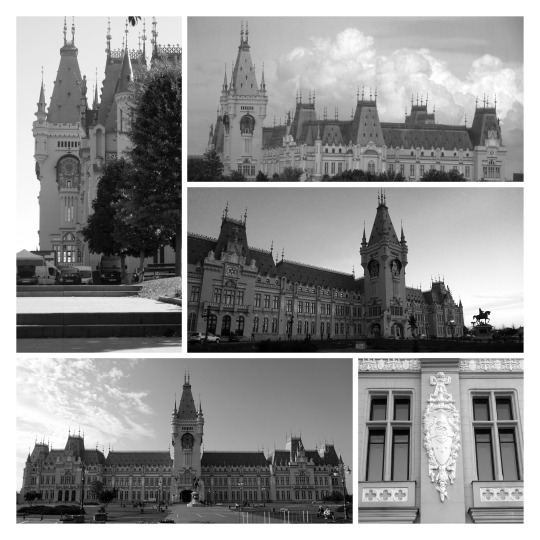
The main attraction and the absolute symbol of Iași, the Palace of Culture represents an emblematic museum of Romania and the headquarters of the National Museum Complex of Moldavia.
The monumental edifice imposes through its height (the 55m tower), surface (268 rooms with a total surface of 35.000 m2) and its privileged position on a promontory of the “Golden Plateau”, the terrace from above the Bahlui river which offers the best visibility.
The current shape of the building is the result of the remake, between 1906 and 1925, of the former residence of Moldavia’s Princes, situated inside the old Princely Court of Iași. The Court was initially erected during the reign of Alexander the Good towards 1400, and documented in 1434. This is where the capital of Moldavia was moved in 1564, during the time of Voivode Alexandru Lăpușneanu, followed by a long consolidation process. On the 27th of May 1600, in the same place, Michael the Brave proclaimed himself “Prince of Wallachia and Transylvania and Moldavia”, a title that no other voivode has had before. The Iași Union of Romanian Principalities for almost a year, later strengthened the ideals of union of Romanians everywhere.
During the first centuries of existence, the Princely Court looked like a fortress, with defence walls, bastions and entrance tower, but the fortifications were removed at the order of the Ottoman Empire. A remodeling takes place under the reign of Vasile Lupu (1634-1653). After some fires and the devastating earthquake in 1802 (7.9 Richter), which destroyed a big part of the constructions, the Prince of Moldavia Alexandru Moruzi builds an imposing Princely Palace (1806-1812) designed by the architect Johan Freywald, similar to Viennese palaces. It is said that it had 365 rooms, one for each day of the year. After a fire, between 1841-1843, Prince Mihail Sturdza ordered the reconstruction of the edifice under the name “The Palace of Reign”. After the 1848 Revolution, Iași was the cradle of Romanian intellectuals’ effort of accomplishing the ideal of Union: “Hey, Wallachian, hey, neighbour, come join me” (“Hora Unirii”, Vasile Alecsandri, 1856). In the Hall of the Elective Assembly in the Palace (situated then above the entrance hallway) the election of Alexandru Ioan Cuza as Prince of Moldavia was confirmed on the January 5th 1859 and the mission of accomplishing the Union was given to him. Cuza’s investiture firman was read here on the 21st of September 1859 by the Turkish colonel Samih-bei. After the decision of moving the capital to Bucharest (1862), the building loses a part of its roles and after the 1880 fire, the palace receives a Neoclassical aspect of French inspiration. In 1883, in front of the Palace, the equestrian statue of Voivode Stephen the Great was erected, with bas-reliefs representing the battle of Moldavia with Poland and with the Ottoman Empire, work of the French sculptor Emmanuel Fremiet. The promise of King Charles I to offer Iasi a true symbol led to the redesign of the edifice in 1906 by the architect Ion D. Berindei, in a Flamboyant Neogothic architectural style, changing its destination into a Palace of Justice and Administration. The inauguration took place on the 11th of October 1925, in the presence of King Ferdinand I and Queen Mary. During the Second World War, it served as barracks of German and then Russian troops and field hospital. Begining with 1955, the edifice received the name “Palace of Culture”, hosting the Museum of History of Moldavia and the Museum Complex.
The building reflects the spirit of ducal palaces in Western Europe, with triumphal hallways decorated with pavement mosaics, very large halls and a rich wall heraldic decoration. In the arrangement of some rooms, ultramodern technologies were used (ventilation system, lighting, vacuum cleaner, clocks synchronized with the one in the tower, etc.) or, as a first, the usage of bois-ciment (“wood-cement”), a decorative material from a mixture of cement and resin, boiled in oil, imitating oak wood, invention of the famous engineer Henri Coandă.
The Palace of Culture shelters four museums of national importance: The Museum of History of Moldavia, The Museum of Art, The Ethnographic Museum and The “Stefan Procopiu” Museum of Science and Technique.
The Union Route proposes an incursion in the Museum of History of Moldavia (left wing, ground floor) which approaches the evolution of the Iași Princely Court, the Iași society in 1900 and its role as Palace of Justice during the interwar period. The testimony of the existence of the Princely Court is present in the medieval foundations visible through glass floors or in the exhibits which approach the evolution of military organization of the capital of Moldavia. The society of Iasi of the 19th century is illustrated through fashionable activities – theatre, photography and sports bets. The role of Palace of Justice is present in the typical Court room or in the former Jury Court in the Henri Coandă Hall. The most impressive room in the Palace is the Voivodes Hall (first floor), a festivity hall with a Gothic arch ceiling, with the portrait gallery of the rulers of Moldavia’s lands, from Decebal to Charles II (Carol II), on a Prussian blue background, and with a superb fireplace symbolically decorated with the genealogic tree of Moldavia’s rulers. The clock tower has the carillon horologe – a drum with pins which operates eight bells. These bells play “Hora Unirii” (composed by the Iasi composer of German origins Alexander Flechtenmacher) at each precise hour, symbol of the essential role that Iași had in the birth of modern Romania. Fifteen minutes before the precise hour, tours are organised in the palace’s attic and tower in order to observe the clock’s mechanism, to experience the vibration of the bells and to admire the superb view over the Old Centre of the city.
The Princely Court ruins (still in arrangement), the effigy of the Rosetti family, from the current Roznovanu Palace and the two cannons (trophies from the Independence War in 1877) harmoniously complete the Palace Square.
(text source: www.iasi.travel)
3 notes
·
View notes
Text
Paris “Pardicé Minuit” Apocalyptic Text; The Referendum: Michaëlis Classification Second Hierarchy; Russe Noir; (Zurich) Delëvoix, Gadreel, Thibodaux, (Paris) Yvës, Loüis, Piërre, (Naples) Domïnique, Alëxandre, Matthïeu est Michaëlis Classification Fleur-de-lys Lightning-Ice War Grigori Seraph-Virtues.
Chapters
1. Angels and Sins
Yvës’s & Delëvoix's Grigori Sin is Thorn Crown (Sin, Passion, Glory) and brings Raver’s Birth (Visual-Spatial Learner Scorpio-Sagittarius Cusp Birth; Chromosomes Prenatal Hormones, Sensory processing disorder (SPD) Fetus Alcohol Consumption)-Audio Clips Extended Production-Raiding Warfare Capture thé Flag, Culture Theory (Esthétique Antagonique) with Cinnamon and Spice Speech.
Princes Du Petit Champlain
Shango, Ogun, & Lion’s Heart
Suisse Personality Triad Angels
Sin City Angels
Paradise Angels
Delëvoix's Classification First Hierarchy
Plutonium Lightning as New Element
Pluto-Uranus Syncretism
2. July 2nd
Montréal Move
Drug War
3. Suprême Court
Murder of a Human
4. COVID-19
École
Assisnation Attempt
Blue Océan Strategy
Retirement
5. The Dirty War and The Dutch Royals
6. Planetary intelligence
URÄNCOIS
7. Bed of a 1000 Roses
8. Esthétique Antagonique
Is an Aesthetic Theory et Culture Antagonism avec Industrial Subculture, Heritage Assets, et Edgy Arts.
Thé Birth of French Culture Theory over Art Movements
Québécois Cross (Crown of Thorns Cross)
Synecdoqu-Métonymie Argot Cul-de-sac
9. Crown of Glory
Lucifer’s, Lilith’s, Hanael’s Death
URÄNCOIS
Québec-Newfoundland and Labrador Border
Suisse Francs
Drapeau Carillon Sacré-Coeur
Secret Expenses
Seraph-Virtue Lightning-Ice Element
Jophiel’s Story: War on Mink Mile
Belphagor’s New Chapter as Monfils
Québec as most powerful French State
10. La Belle Époque Quinze (Français Russian)
Russian Chess Psychology, Slovaj Lacanien Triad, Prague Underground, et Sociocultural Theory of Development
Baroque
Sculpture
Romanticism
Chess
Social Science
Natural Science
Beaux-Arts
Architecture
Newfoundland and Labrador Movement: Pont-Aven is a commune of the Finistère département, in Brittany, France, some distance inland from where the river Aven meets the Atlantic Ocean. From the 1850s painters began to frequent the village of Pont-Aven, wanting to spend their summers away from the city, on a low budget in a picturesque place not yet spoilt by tourism.
Dévelopment of Québécois Mirrors of Princes Literature De Administrando Imperio ("On the Governance of the Empire") et De ordine palatii (On the governance of the palace)
RUSSE NOIR
0 notes